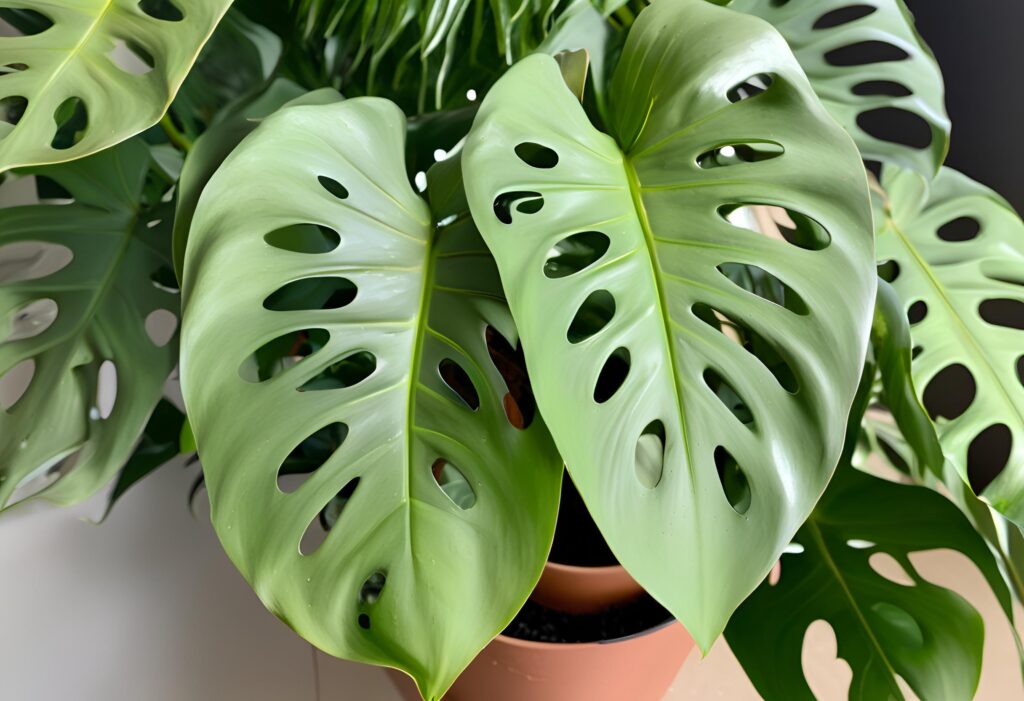The monstera adansonii plant is referred to as the Swiss cheese plant. It is famous among plant enthusiasts because of its easy care and lush foliage. Due to a process called the fenestration, distinctive holes are created on the leaves. The leaf pattern resembles Swiss cheese to a certain extent. The monstera adansonii plant is amazing since it requires bright, indirect sunlight.
The monstera adansonii is tropical, and native to Central and South America. In nature, it grows up to 10-13 feet but in the indoors it’s 3-8 feet. The Swiss Cheese plant is vining and has a growth rate of 2-3 feet a year. Even though they have characteristics similar to those of monstera deliciosa, the growth rate is higher. The monstera adansonii plants are suitable for indoor planting. They induce green pop that elevates your interior space.
Today I will talk about the Swiss Cheese plant(monstera adansonii) and how to care for, grow, repot, propagate, and nurture them.
Planting monstera adansonii:
Pot :
The ideal pot for this plant is with a drainage hole. You should ensure the length of the pot is slightly higher than the roots. You can go for a terracotta or plastic pot with a hole at the bottom. I prefer the terracotta one because it looks aesthetic.
Potting mix:
It is ideal to opt for a well-drainage potting mix. I make my potting blend with peat moss, perlite, and pine bark. It works great so you can go for the blend as well. But ensure it is a well-drainage blend.
Planting process:
- Firstly, create a layer of broken pottery or small rocks.
- After that add your potting mix now plant your monstera adansonii plant add soil rich with organic minerals.
- Be careful while removing the plant from the nursery pot.
- Again add some potting mix on top and gently pad down.
- Finally, water your plant until it flows down the drainage hole.
Repotting monstera adansonii:
Repot your monstera adansonii every two years for better growth and beautiful foliage. Ensure to increase the pot size by an inch and add new soil for more growth. The ideal time to repot is in the growing season(spring).
Monstera adansonii plant care:

Light:
It thrives in bright, indirect light. I tend to give about 2-3 hours of morning sunlight. It helps them to grow more profound foliage. But too much exposure to direct sun will scorch the leaves. Placing the plant indoors in proper condition will improve its growth.
Water:
Swiss cheese (monstera adansonii) plants prefer moist environments over soggy ones. Only water the plant when the top inch is dry otherwise overwatering can cause root rot.
Humidity:
This plant thrives in highly humid places. The humidity should be around 55-65% and if your place is dry, consider using a humidifier. It helps my plant a lot. So, go for a mist maker or humidifier.
Pro Tip: Place your plant on a tray of water with pebbles. This will allow more humidity for your plant.
Temperature:
The perfect temperature for monstera adansonii is about 65-85 Fahrenheit. Since it is a tropical plant and prefers warm weather, you must avoid cold.
Fertilizer:
You should use a well-balanced water-soluble fertilizer for the plant in the growing season(spring and summer). Any household fertilizer will work but apply once a month in the growing season and avoid in fall and winter.
Pruning and support:
The monstera adansonii plant requires easy pruning, removing the yellow or dead leaves. This plant is a vining plant and a remarkable climber. I use moss poles which also support their growth. It’s better to place a pole or stick at the center and stake it up so it can climb. It will help the plant to stay inside the pot. You should also cut the stem right above a leaf node so it stays in place.
Propagating monstera adansonii plant:
The Swiss cheese plants are easy to propagate but in the spring season. The best way to do it is by cutting the stem. But the stem must be healthy with 2-3 nodes. It’s essential to use sharpe sheer.
- Cut the stem just below a node, it must be 4-6 inches long with a few leaves.
- It’s ideal to remove any leaves on the bottom third and dip the cut in a rooting hormone.
- Insert the cut in a potting mix and ensure the pot is well-drainaged. Place it in warm indirect light. Pour water thoroughly and let it settle.
- Provide 65-85 Fahrenhite, maintain bright, indirect light, and care until the stem is established.
- A well-formed stem will appear within a month. After the cut is ready transfer it into a regular pot and follow the planting process.
You can also use soil propagation and follow the first two-step, then insert the node in the water tray, Refresh the water in a few days continuously until the stem is well established. Then follow the last steps to complete the propagation.
Monstera adansonii plant common issues:
The monstera adansonii plants are easy to care but there are some common issues that you may face.

Brown or Yellow leaves:
This happens because of overwatering or underwatering. Ensure the pot has a good draining system and create a chore chart for the watering schedule.
Leaf drop:
The leaf drop happens due to temperature change or change in overall plant environment. It is advised to avoid any sudden change and ensure your plant gets enough water and bright, indirect light. You should know that too much direct sunlight can also cause leaf drop.
Leaves curling:
Underwatering is a major reason for leaves curling or wrinkling. To prevent this pour water thoroughly and ensure pot drainage. When the top two inches of the soil is dry, it’s a requirement water sign.
Leaves not splitting:
The monstera adansonii plants have a distinctive look caused by fenestration. This creates the Swiss cheese’s appearness but if it doesn’t get enough sunlight, then the result is different. You have to ensure the light conditions. The Swiss cheese plants need bright, indirect light for growth and healthy leaves.
Leaf turning black:
This problem is caused by exposure to direct sunlight. Keeping your plant in direct sunlight for more than 2-3 hours may cause black spots or scorching. Maintain the light exposure and ensure better leaf health.
Pest:
Common household insects like spider mites, mealybugs, and scale insects cause issues to your plant. I recommend using neem oil or insecticidal soap and inspecting daily is a great help.
Poor growth:
The poor growth takes place due to low light or lack of nutrients. Ensure proper bright, indirect sunlight and well-balanced fertilizer. Change the soil while repotting, it will add essential nutrients.
Is monstera adansonii Pet-friendly:
No, the monstera adansonii plants are not pet-friendly. By ingesting or chewing your pet might get intoxicated. Taking to the vet is the best option. I prefer to keep the plants at a higher place so they won’t reach it.

Interesting facts about monstera adansonii:
The monstera adansonii has smaller distictive holes than monstera deliciosa. This fenestration helps the plant to capture the light better. Some people are confused about the monstera deliciosa and monstera adansonii since they have the same first name. In the wild, it grows as an epiphyte and climbs up the tree with the help of its roots. The monstera adansonii plant is native to the rainforests of Colombia, Brazil, and French Guiana. In the wild, it produces fruits that some native populations tend to eat. But this doesn’t occur indoors and even in nature, it’s rare. Indoor the plant works as a good air purifier. In some cultures, it bears positive symbolism such as adaptability and growth. Some people are confused about the monstera deliciosa and monstera adansonii since they have the same first name.
So this is the end of this blog, I will recommend you to own a monstera because it’s a beautiful easy-to-care plant that suits the indoor space. I have had this plant for over a year and I love the fact that it compliments my living. I have repotted the plant once and it’s growing steadily. Often I use neem oil to prevent insects and prune when required.






Leave a Reply